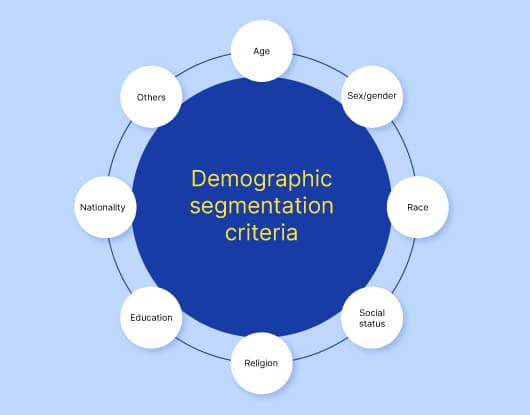Describe Your Target Market Using Demographic Segmentation Factors
However a target market of firms within a radius of 20 miles with annual revenues of 10 to. Learn how businesses can use demographic segmentation to add value to their products messaging and bottom line.

What Is Demographic Segmentation Voxco
Youll be spending your marketing dollar more wisely by targeting audiences that are willing and able to endorse your product.

. The purpose of demographic geographic and psychographic. Target markets include more details. Once youve considered the key demographic factors you can begin to assemble a customer profile a more focused statement that describes your target market in detail.
Demographic Geographic Psychographic. You can market more efficiently by homing in on your customers incomes family size and even level of education. Demographic Segmentation Demographic segmentation is extremely important to all marketing departments since the data is easily available and does drastically affect buying patterns.
Market segmentation is the process of dividing a target market into smaller more defined categories. Consult that profile when you make decisions about issues such as what products and services to offer or advertise how much to charge for various products and expansion plans. The most common demographic segments are income age gender ethnic background family life cycle and income.
Demographic segmentation helps marketers be very specific about their target market. Demographics include age income occupation and other similar variables that describe a group of people. It segments customers and audiences into groups that share similar characteristics such as demographics interests needs or location.
Demographic Segmentation Demographic grouping is based on measurable statistics such as. The most commonly used demographic segmentation factors are. Geography and demographics are therefore that much more valuable because they provide that up-close-and-personal understanding.
For example a printers target of mid-sized firms with mid-size projects is not a measurable definition. Demographic segmentation refers to the categorization of the target market based on specific variables like age education and gender. Its nuanced and full of more variables than we like to acknowledge.
Demographic market segmentation extends beyond age and gender though. In demographic segmentation an organization has an advantage because it can drill its target market down to a specific demographic targeting factors such as age gender or ethnicity. To investigate the effect of dependency ratio.
Gender Age Income level Marital status Education Race Religion Demographic segmentation is usually the most important criterion for identifying target markets which means that knowledge of demographic information is crucial for many businesses. The simplest way to adopt demographic segmentation is by using factors like age gender income but there are many non-character traits that you can focus on. Heres the thing though defining your target marketing through demographic or geographic marketing isnt a cut-and-dried process.
Demographic Segmentation - This market segment includes attributes like age gender ethnicity religion location income education etc. Demographic segmentation is one market research tool you should use to better understand your customers. The market should be measurable sufficiently large and reachable.
These are the most effective strategies to divide people into an identical subgroup. As you can see the list goes on and on. Routine requirements uncertaintiespurchasing powers use of the products etc Your analysis of the product suitability for the market.
Demographic Geographic Psychographic segmentation refers to the market segmentation technique based on the different factors related to the audiences. Demographic geographic andpsychographic factors Outline consumer attributes based on the market profile eg. It may seem like super dry information it is but it will help you tremendously when you are creating your ads.
This type of market segmentation predominantly uses 7 factors to identify customer segments. Demographic segmentation is a way to break down large heterogeneous markets into smaller markets that are more likely to respond to. From a consumer prospective using a checklist against the.
It is a type of market segmentation that helps businesses to understand their consumers better and meet their needs effectively. Eight Benefits of Market Segmentation. To create a target market a company often does not solely rely on.
Companies use surveys at one point in time or at several points in time to understand changes in customer preferences and behaviors. They can create a target market using those demographics such as single women between the ages of 18 and 35 who make between 50000 and 80000 annually. Targeting your market is simply defining who your primary customer will be.
Segmentation helps you create customer profiles that allow you to target your marketing strategies more effectively. Demographic Segmentation divides the market into groups based on variables such as age gender family size family life cycle income occupation education religion race generation and nationality. Describe the target market segment target market profile.
In using these marketers have a greater ability to reach the most desired target market for the given product. This market segmentation process can help form an effective B2B marketing strategy by identifying target customers and tailoring. You can segment demographically by age gender family size family lifecycle generation income occupation education ethnicity language preference and religion.
In fact demographic segmentation probably offers the widest variety of segmentation variables than any other technique.

What Is Demographic Segmentation With 5 Examples

Demographic Segmentation Defined With 5 Examples Yieldify


No comments for "Describe Your Target Market Using Demographic Segmentation Factors"
Post a Comment